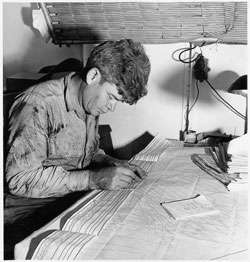Maurice Ewing
| Maurice Ewing | |
|---|---|
|
Maurice Ewing in 1948. Photo courtesy Columbia University | |
| Born |
William Maurice Ewing May 12, 1906 Lockney, Texas |
| Died |
May 4, 1974 (aged 67) Galveston, Texas |
| Nationality | American |
| Fields |
geophysics underwater acoustics oceanography |
| Institutions |
Columbia University University of Texas |
| Alma mater | Rice University |
| Doctoral advisor | L Don Leet |
| Influenced |
J. Lamar Worzel Frank Press Jack Nafe Jack Oliver |
| Notable awards |
Alexander Agassiz Medal (1954) William Bowie Medal (1957) Cullum Geographical Medal (1961) John J. Carty Award (1963) Wollaston Medal (1969) National Medal of Science (1973) Vetlesen Prize (1960) Fellow of the Royal Society (1972)[1] Penrose Medal (1974) |
William Maurice "Doc" Ewing (May 12, 1906 – May 4, 1974) was an American geophysicist and oceanographer.[1][2][3][4][5][6]
Ewing has been described as a pioneering geophysicist who worked on the research of seismic reflection and refraction in ocean basins, ocean bottom photography, submarine sound transmission (including the SOFAR channel), deep sea coring of the ocean bottom, theory and observation of earthquake surface waves, fluidity of the Earth's core, generation and propagation of microseisms, submarine explosion seismology, marine gravity surveys, bathymetry and sedimentation, natural radioactivity of ocean waters and sediments, study of abyssal plains and submarine canyons.
Biography
He was born in Lockney, Texas, where he was the eldest child of a large farm family. He won a scholarship to attend Rice University, earning a B.A. with honors in 1926. He completed his graduate studies at the same institution, earning an M.A. in 1927 and being awarded his Ph.D. in 1931. In 1928 he was married to Avarilla Hildenbrand, and the couple had a son.
He moved to Columbia University, becoming a professor of geology in 1947. In 1959 he was named the Higgins Professor of Geology at Columbia. Dr. Ewing (often simply called 'Doc' by those who worked with him) was the founder (established in 1949) and first director of Lamont Geological Observatory (now known as Lamont-Doherty Earth Observatory (LDEO) in Palisades, New York) where he worked with J. Lamar Worzel (gravity specialist), Dr. Frank Press (seismologist), Jack Nafe, and Jack Oliver. The former LDEO research vessel R/V Maurice Ewing was named in his honor.
He divorced a second time, and married Harriet Greene Bassett in 1965. In 1972 he joined the University of Texas Medical Branch at Galveston, and was named the head of the Division of Earth and Planetary Sciences of the Marine Biomedical Institute.
During his career he published over 340 scientific papers. He served as president of the American Geophysical Union and the Seismological Society of America. He led over 50 oceanic expeditions. He made many contributions to oceanography, including the discovery of the SOFAR Channel, the invention of the sofar bomb, and did much work fundamental on plate tectonics. He was the chief scientist on board the Glomar Challenger. He originated Project Mogul, an early program to detect Soviet nuclear weapons tests.
Awards and honors
- Penrose Medal, 1974 (posthumously)
- Walter H. Bucher Medal, 1974
- William Bowie Medal, 1957
- Arthur L. Day Medal, 1949
- John J. Carty Award of the National Academy of Sciences, 1963[7]
- Distinguished Public Service Award, 1955
- Sidney Powers Memorial Medal, 1968
- Robert Earl McConnell Award, 1973
- National Medal of Science, 1973
- Vega Medal of the Swedish Society for Anthropology and Geography, 1965
- Cullum Geographical Medal of the American Geographical Society, 1961
- Gold Medal of the Royal Astronomical Society, 1964
- Elected to the National Academy of Sciences
- Elected a Foreign Member of the Royal Society (1972)[1]
- Elected to the American Academy of Arts and Sciences
- Elected to the American Philosophical Society
- Foreign Member of the Geological Society of London, 1964
- Guggenheim Fellow, 1938, 1953, 1955
- Vetlesen Prize, 1960[8]
- Eleven honorary degrees
- Geophysics Laboratory at the University of Texas Medical Branch Marine Science Institute was renamed Maurice Ewing Hall.
- The Maurice Ewing Medals of the Society of Exploration Geophysicists and American Geophysical Union were named after him.
- The lunar wrinkle ridge Dorsa Ewing was named after him.
See also
References
- 1 2 3 Bullard, E. (1975). "William Maurice Ewing 12 May 1906 -- 4 May 1974". Biographical Memoirs of Fellows of the Royal Society. 21: 268–226. doi:10.1098/rsbm.1975.0007.
- ↑ Drake, C. L. (1974). "Maurice Ewing". Physics Today. 27 (7): 59–51. doi:10.1063/1.3128712.
- ↑ Maurice Ewing and the Lamont-Doherty Earth Observatory
- ↑ Benioff, H. (1951). "Sound Waves in the Atmosphere Generated by a Small Earthquake". Proceedings of the National Academy of Sciences. 37 (9): 600. Bibcode:1951PNAS...37..600B. doi:10.1073/pnas.37.9.600.
- ↑ Oliver, J. (1958). "Seismic Surface Waves at Palisades from Explosions in Nevada and the Marshall Islands". Proceedings of the National Academy of Sciences. 44 (8): 780. Bibcode:1958PNAS...44..780O. doi:10.1073/pnas.44.8.780.
- ↑ Ewing, M. (1959). "Significance of the Worzel Deep Sea Ash". Proceedings of the National Academy of Sciences. 45 (3): 355. Bibcode:1959PNAS...45..355E. doi:10.1073/pnas.45.3.355.
- ↑ "John J. Carty Award for the Advancement of Science". National Academy of Sciences. Archived from the original on 29 December 2010. Retrieved 25 February 2011.
- ↑
External links
- Photo
- Excellent Video Lecture Explaining SOFAR Spheres
- National Academy of Sciences Biographical Memoir
